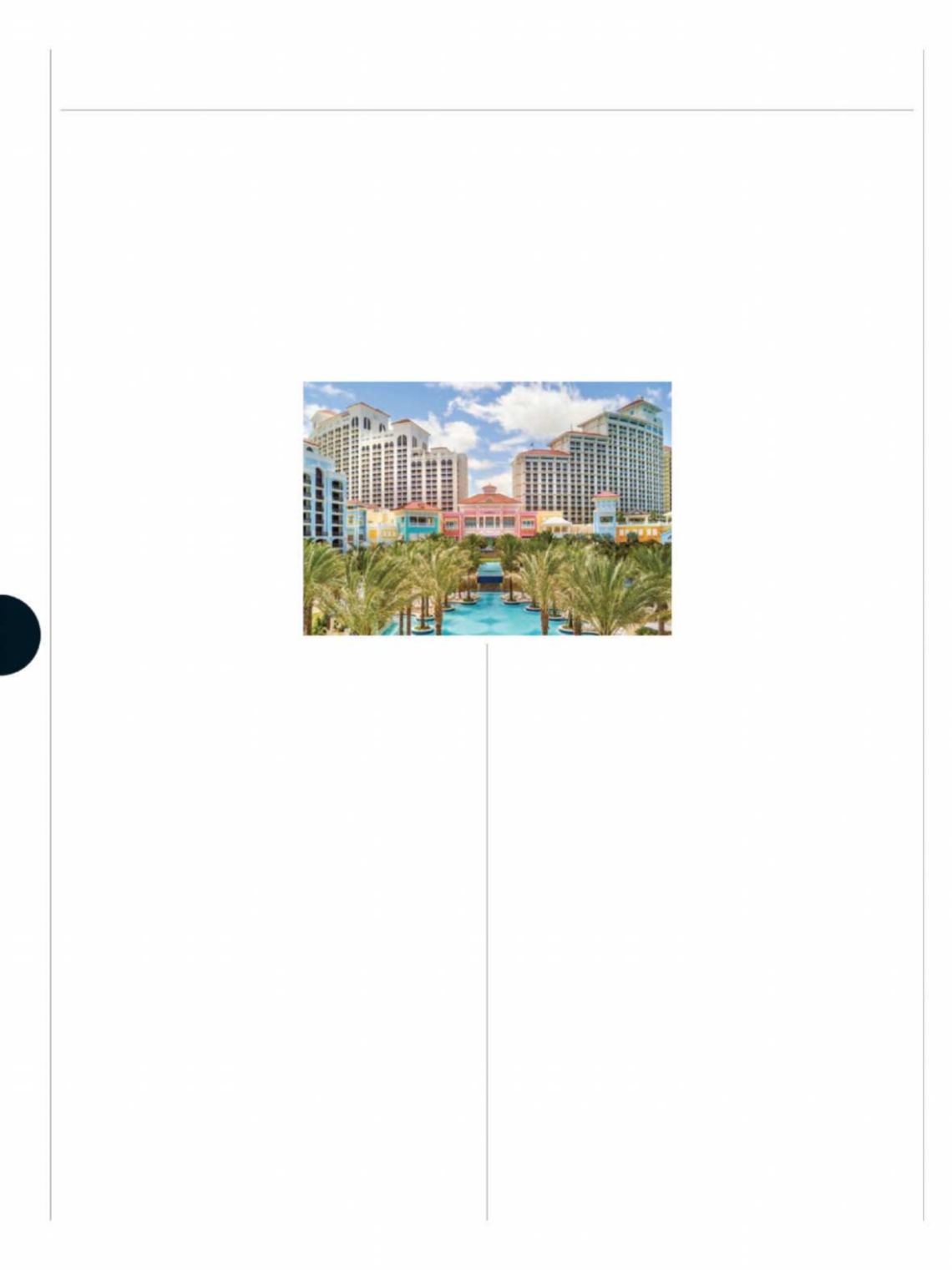
CRITIC
May 14, 2018
78
From a balcony at the six-month-
old SLS hotel in the Bahamas,
there’s an expansive view of the
main grounds of the Baha Mar
resort: Clusters of palms, rows of
sherbet-colored chaise longues,
crisp white umbrellas, and slivers
of turquoise pools. Beyond lies
the beach and the ombré ocean.
It looks like heaven. And it can
sound like hell.
Baha Mar, now humming with
guests from around the globe
enjoying its play pools and daytime dance parties, has been
opening in phases since April 2017. That’s more than a decade
after developer Sarkis Izmirlian promised the rebirth of
Cable Beach, a prime stretch 5 miles from downtown Nassau.
With six hotels, 50 restaurants, a casino, and a Jack Nicklaus-
designed golf course, the megaresort was expected to generate
12 percent of the Bahamas’ gross domestic product.
The so-called “new Riviera” cost more than $4 billion, mak-
ing it the largest and most expensive resort in the Caribbean.
In 2015 it went bust, a victim of bad timing, overspending,
and allegations of contractor malfeasance. A bailout came
the following year, when Hong Kong-based Chow Tai Fook
Enterprises Ltd., the owner of Rosewood Hotel Group, bought
the whole property out of bankruptcy. At the time, it was
90 percent inished. And 100 percent vacant.
Now, electronica thumps from the SLS’s adults-only
“Privilege” pool, where revelers do bottle-service-fueled
dances on reserved daybeds. The
untz-untz
knocks up against
the sounds of Beyoncé playing at the long, slim Bungalow
pool next door, where bachelorettes in coordinated bikinis
day-drink on pastel chaises. The families staying at the Grand
Hyatt (rooms from $225) cluster around other pools nearby
with their own soundtracks, including one with windows
looking onto the property’s shark-illed mini-aquarium and
another equipped with “rain cabanas” whose walls are made
from streams of water.
With a staggering 2,300 guest rooms, Baha Mar needs to be
all things to all people. Doing that without feeling generic—a
word that’s become anathema to hoteliers—is a tall order.
PHOTOGRAPH COURTESY GRAND HYATT BAHA MAR
Yet Baha Mar seems to be suc-
ceeding. The convenient location
helps: You can have breakfast in
New York and lunch at the resort.
There’s no need to leave the
grounds, where you’ll ind golf,
tennis, baccarat tables, a kids club,
and dozens of restaurants. There
are even lashes of Bahamian cul-
ture, like a conch shack. The lux-
ury of so much choice feels fun
and indulgent—and not too tacky.
Despite the high-proile bank-
ruptcy still visible in the resort’s rear-view mirror, business is
brisk. “We’ve exploded our budget every month,” says Charles
Dessert, marketing manager for the SLS (rooms from $355). His
hotel and the year-old Grand Hyatt have at times been sold out.
And with drinks at $21 a pop and a 100,000-square-foot casino,
there’s plenty of revenue to be made.
But the magic begins to wear of after a few days. The myr-
iad themed areas and their background noise devolve from a
carefully orchestrated fantasy to a cacophony of hospitality.
The design throws together concrete towers, tile roofs, and
colonial gingerbread trim. Dining options include a Starbucks,
a French-style bakery, a Mexican taco truck, a Chinese noodle
shop, and a dimly lit English pub.
There’s arguably one unifying thread (besides the cake-lour
beach) at Baha Mar: Instagram. At Privilege, a blonde in cherry-
red sunglasses and a matching swimsuit seeks the right angle
for her pool selie. A few feet away, another woman reclines
for a shot in a lamingo loatie. A hot-pink Airstream food truck
near the pier awaits further perfect photos. Online, without
the real-life noise, they’ll look vivid and serene.
Actual serenity may come in June, when a high-end
Rosewood hotel opens. Known for sophisticated spots such
as the Carlyle in New York and Hôtel de Crillon in Paris,
Rosewood aims to have its ofering feel disconnected from
the rest of the resort. The only way to reach the other facili-
ties will be to walk along the beach.
“It will feel like an island estate home,” says Luigi
Romaniello, managing director for the property. Just one with
1,500 slot machines at hand and a water park to come.
The enormous $4 billion Baha Mar resort filed for bankruptcy
in 2015, a failure before it ever welcomed a single guest.
Now it’s open—and business is booming. By Sara Clemence
P A R A D I S E , M A N U F A C T U R E D
A L L A B O U T
T H E C A R I B B E A N








